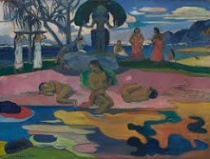Post-impressionism is an artistic movement that emerged at the end of the 19th century . Also mentioned as post-impressionism as accepted by the Royal Spanish Academy ( RAE ) in its dictionary, it emerged as a response to impressionism .
 To define what post-impressionism is, therefore, reference must first be made to impressionism. This is the name given to a movement that was born in the 19th century in French territory, focused on the representation of objects based on the impression they generate on the eye at a precise moment and according to the luminosity.
To define what post-impressionism is, therefore, reference must first be made to impressionism. This is the name given to a movement that was born in the 19th century in French territory, focused on the representation of objects based on the impression they generate on the eye at a precise moment and according to the luminosity.
The impressionists, in short, sought to capture the visual impression caused by light . Those artists who sought to transcend the limitations of this position were responsible for the development of post-impressionism.
According to art specialists, post-impressionism set out to give painting more expressiveness . For this, its promoters reflected their particular ( subjective ) vision in their paintings, pouring their emotions into the works.
It is important to mention that impressionism was based on spontaneity and the registration of what was perceived with the senses at a given moment. Post-impressionism, for its part, allowed itself greater freedom and left aside the impressionist “barriers.”
In addition to the characteristics presented, we have to establish that post-impressionism has others such as the use of elements with great symbolism, the creation of fairly thick brush strokes and even the use of colors that are artificial. Specifically, they use colors that are very striking.
Likewise, other important signs of identity should not be overlooked, such as the following:
-There is great interest among its artists in developing new pictorial and artistic techniques. Hence, for example, everything from pointillism to the geometrization of elements and objects of everyday life appear.
-Of course, we must not overlook that they have a huge interest in the exotic. Hence the post-impressionists had a lot of interest in Ancient Egypt, in primitive cultures, in the East...
The person responsible for coining the notion of post-impressionism was the British Roger Fry , who organized an exhibition in 1910 called “Manet and the Post-Impressionists” . In the exhibition in question there were works by Vincent Van Gogh , Paul Gauguin and Paul Cézanne , among other creators who, over the years, ended up being included in the group of post-impressionists.
In the same way, to this group of post-impressionists we must add other artists who also qualified as such and who have become key figures in the history of art. We are referring, for example, to Georges Seurat, Henri Rousseau or even Henri Toulouse-Lautrec.
Among the most relevant works of art of Post-Impressionism we can highlight some such as “At the Moulin Rouge” (1890) by Toulouse-Lautrec, “Sunday Afternoon on the Island of La Grande Jatte” (1886) by Seurat or “The Bathers”. ” (1905) by Cézanne. And these would be joined by others such as “Yellow Christ” (1889) by Paul Gauguin or “Coffee Terrace at Night” (1888) by Vincent Van Gogh.
